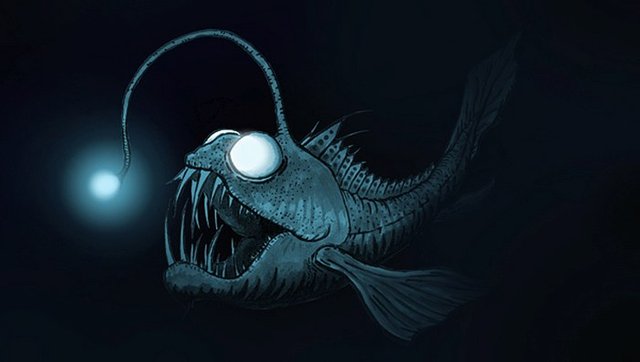A GLIMPSE ON BIOLUMINESCENCE
Introduction

Image Source
What if we have our own source of light that we may never come to think about where to look for a source?
What if we want to travel amidst the night? Or else we want to voyage? What could be our source of light which can lit our way to reach towards our destination? But what if we ourselves exhibit a very own characteristic which could light our sight in order to settle in the night? It would be very cool that humans could have an extraordinary characteristic that will make us unique from other creatures but it couldn't be possible since humans are already created this way.
Though humans can't create our own light, some animals do, in a process called bioluminescence. Fireflies are perhaps the best known example, though many other species are bioluminescent, including glow worms, anglerfish, and octopus. Even some plants, such as mushrooms and other fungi, are bioluminescent.
This blog offers you an information about the process of self-exhibition called Bioluminescence which is partially discussed above. This also offers an insight about how bioluminescence is exhibited and what elements are present in an organism that could be used to illuminate and exhibit their own light.
What is Bioluminescence?
Bioluminescence is the production and emission of light by a living organism as the result of a chemical reaction during which chemical energy is converted to light energy.
Bioluminescence is a "cold light." Cold light means less than 20% of the light generates thermal radiation, or heat.
How is it produced?

Image Source
Most bioluminescent organisms are found in the ocean. These bioluminescent marine species include fish, bacteria, and jellies. Some bioluminescent organisms, including fireflies and fungi, are found on land. There are almost no bioluminescent organisms native to freshwater habitats.
The Chemistry Side
The chemical reaction that results in bioluminescence requires two unique chemicals: luciferin and either luciferase or photoprotein. Luciferin is the compound that actually produces light. In a chemical reaction, luciferin is called the substrate. The bioluminescent color (yellow in fireflies, greenish in lanternfish) is a result of the arrangement of luciferin molecules.
Luciferase is an enzyme. An enzyme is a chemical (called a catalyst) that interacts with a substrate to affect the rate of a chemical reaction. The interaction of the luciferase with oxidized (oxygen-added) luciferin creates a byproduct, called oxyluciferin. More importantly, the chemical reaction creates light.
Bioluminescent organisms can glow in complete darkness. They contain a unique compound called luciferin, according to scientists who study bioluminescence at the University of California at Santa Barbara. When luciferin is exposed to oxygen, a chemical reaction (aided along by an enzyme called luciferase) emits light.
Bioluminescence's Advantage to Species

Image courtesy of Terry Priest;
image source: Flickr

Image Source
Bioluminescence – light produced by living organisms – is widespread in nature, but what advantage does it give the species that use it? In fact, there are many, including:
- Aposematism (toxic appearance) – to look inedible to potential predators.
Example: the fireflies Photinus ignitus and Lucidata atra. - Defence – to startle predators by emitting a bright flash at close range.
Example: sternchasers, a type of myctophid or lanternfish. - Courtship – to communicate before or during mating.
Example: fireflies. - Lures – to attract prey to the light source.
Example: the angler fish. - Camouflage – to help the animal to blend in with its background. As seen from below, a sea animal will look dark against the brightness of the water surface above, so producing its own light will help it to hide from potential predators.
Example: squids such as Abralia verany.

Image Source
Bioluminescence has fascinated people for thousands of years and continues to be a popular subject of research, particularly in oceanic exploration projects. The chemical reactions that lead to the production of light by organisms are a great example of biochemistry.Perhaps the most spectacular bioluminescence displays come from dinoflagellate plankton, which cause the glowing blue waves sometimes seen on the ocean’s surface. More exotic forms of bioluminescence are found in the ocean depths; where there is no sunlight at all, many species make their own illumination. Famously, angler fish use a dangling light to lure their prey straight to their teeth.
References
- https://www.livescience.com/32651-what-causes-bioluminescence-.html
- http://www.scienceinschool.org/content/living-light-chemistry-bioluminescence
- https://www.nationalgeographic.org/encyclopedia/bioluminescence/
- https://www.sciencedaily.com/terms/bioluminescence.htm
- Marie Walsh, Limerick Institute of Technology, Ireland
Chemistry, Biology, Luminescence, Ecology

Amazing jellyfish !
It really is!
Enjoyed this sir. When I was a young child my parents took me to a beach called La Parguera in Puerto Rico. We went on a boat ride for a out half an hour that took us to “las aguas Flourescentes”, literally means Fluorescent waters, or in English its called phosphourescent bay. There was and still are fluorescent plankton on this bay. As you approach the bay you can see the water lighting up behind the boat from the turbulance of the propeller. The closer you get, the brighter it gets. The boat stops after a while and they let you swim in the water and as you swim and splash yhe water lights up quite brightly. Also when fish swim by you can see a trail of light behind them. Awesome place. I am sure there are other places like this. Of course it was at night that we did this. Great post. Thanks.
How I also wish I could swim with planktons :)
thank u
Wow thank you for sharing..
youre welcome